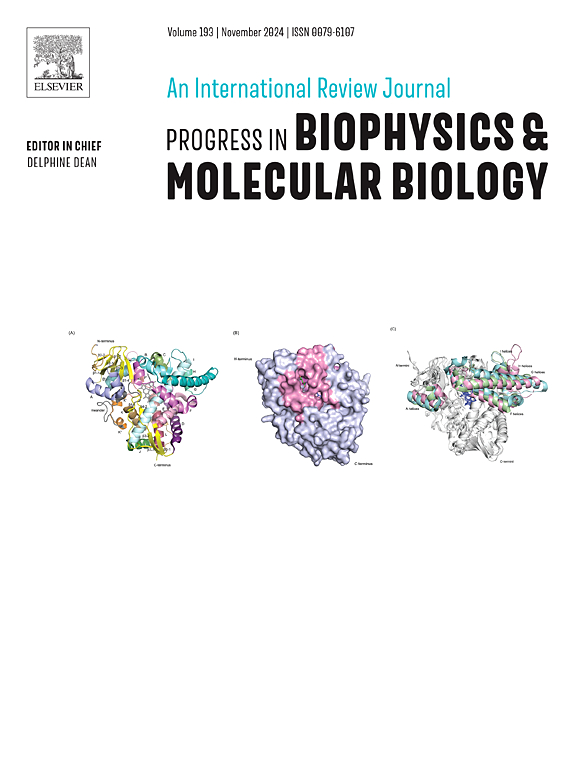静脉畸形的细胞异质性和组织特异性:发病机制和靶向治疗的意义
IF 4.5
3区 生物学
Q2 BIOCHEMISTRY & MOLECULAR BIOLOGY
Progress in Biophysics & Molecular Biology
Pub Date : 2025-06-18
DOI:10.1016/j.pbiomolbio.2025.06.002
引用次数: 0
摘要
背景:静脉畸形(VMs)是一种常见的血管异常,其特征是内皮细胞增生异常、血管壁细胞缺乏和血管结构不规则。虽然致病性基因突变是VMs的遗传基础,但其细胞异质性、组织特异性和潜在机制仍知之甚少。VMs越来越被认为是具有肿瘤样机制的血管异常,强调了细胞异质性和组织特异性在发病机制中的关键作用。方法系统回顾近年来VMs的研究进展,重点关注细胞异质性和组织特异性。它总结了关键的突变基因,各种细胞类型的作用,以及它们在病变中的相互作用。通过比较动脉和静脉的生理差异,我们探讨了vm的组织特异性起源。此外,我们评估了目前的细胞和动物模型,讨论了它们在模拟病理特征方面的优势和局限性,包括细胞异质性和组织特异性。结果VMs的发生与内皮细胞的基因突变以及内皮祖细胞、血管壁细胞和其他血管周围细胞的功能改变密切相关。病变组织在细胞功能、基因/蛋白表达和信号转导方面表现出显著的异质性。组织特异性受环境因素、组织结构和动脉和静脉基因表达差异的影响,这解释了为什么vm主要影响静脉。结论支持向量机的发展涉及致病基因突变、细胞异质性和组织特异性之间的相互作用。了解这些机制将有助于阐明vm的发病机制并为精确治疗提供信息。未来的研究应集中在细胞类型的相互作用,组织特异性在疾病进展中的作用,并制定有针对性的治疗策略。本文章由计算机程序翻译,如有差异,请以英文原文为准。
Cellular heterogeneity and tissue specificity in venous malformations: Implications for pathogenesis and targeted therapies
Background
Venous malformations (VMs) are common vascular anomalies characterized by abnormal endothelial cell proliferation, a paucity of vascular wall cells, and irregular vascular structures. While pathogenic gene mutations are the genetic basis of VMs, the cellular heterogeneity, tissue specificity, and underlying mechanisms remain poorly understood. VMs are increasingly recognized as vascular anomalies with tumor-like mechanisms, highlighting the critical roles of cellular heterogeneity and tissue specificity in pathogenesis.
Methods
This review systematically examines recent advances in VMs research, focusing on cellular heterogeneity and tissue specificity. It summarizes key mutated genes, the roles of various cell types, and their interactions within lesions. By comparing physiological differences between arteries and veins, we explore the tissue-specific origins of VMs. Additionally, we evaluate current cellular and animal models, discussing their strengths and limitations in simulating pathological features, including cellular heterogeneity and tissue specificity.
Results
The development of VMs is strongly linked to genetic mutations in endothelial cells, as well as functional alterations in endothelial progenitor cells, vascular wall cells, and other perivascular cells. Lesion tissues exhibit significant heterogeneity in cell function, gene/protein expression, and signal transduction. Tissue specificity is influenced by differences in environmental factors, tissue structure, and gene expression between arteries and veins, explaining why VMs predominantly affect veins.
Conclusions
VMs development involves interactions among pathogenic gene mutations, cellular heterogeneity, and tissue specificity. Understanding these mechanisms will elucidate VMs pathogenesis and inform precision therapies. Future research should focus on cell-type interactions, the role of tissue specificity in disease progression, and developing targeted therapeutic strategies.
求助全文
通过发布文献求助,成功后即可免费获取论文全文。
去求助
来源期刊

Progress in Biophysics & Molecular Biology
生物-生化与分子生物学
CiteScore
8.60
自引率
7.90%
发文量
85
审稿时长
85 days
期刊介绍:
Progress in Biophysics & Molecular Biology is an international review journal and covers the ground between the physical and biological sciences since its launch in 1950. It indicates to the physicist the great variety of unsolved problems awaiting attention in biology and medicine. The biologist and biochemist will find that this journal presents new and stimulating ideas and novel approaches to studying and influencing structural and functional properties of the living organism. This journal will be of particular interest to biophysicists, biologists, biochemists, cell physiologists, systems biologists, and molecular biologists.
 求助内容:
求助内容: 应助结果提醒方式:
应助结果提醒方式:


